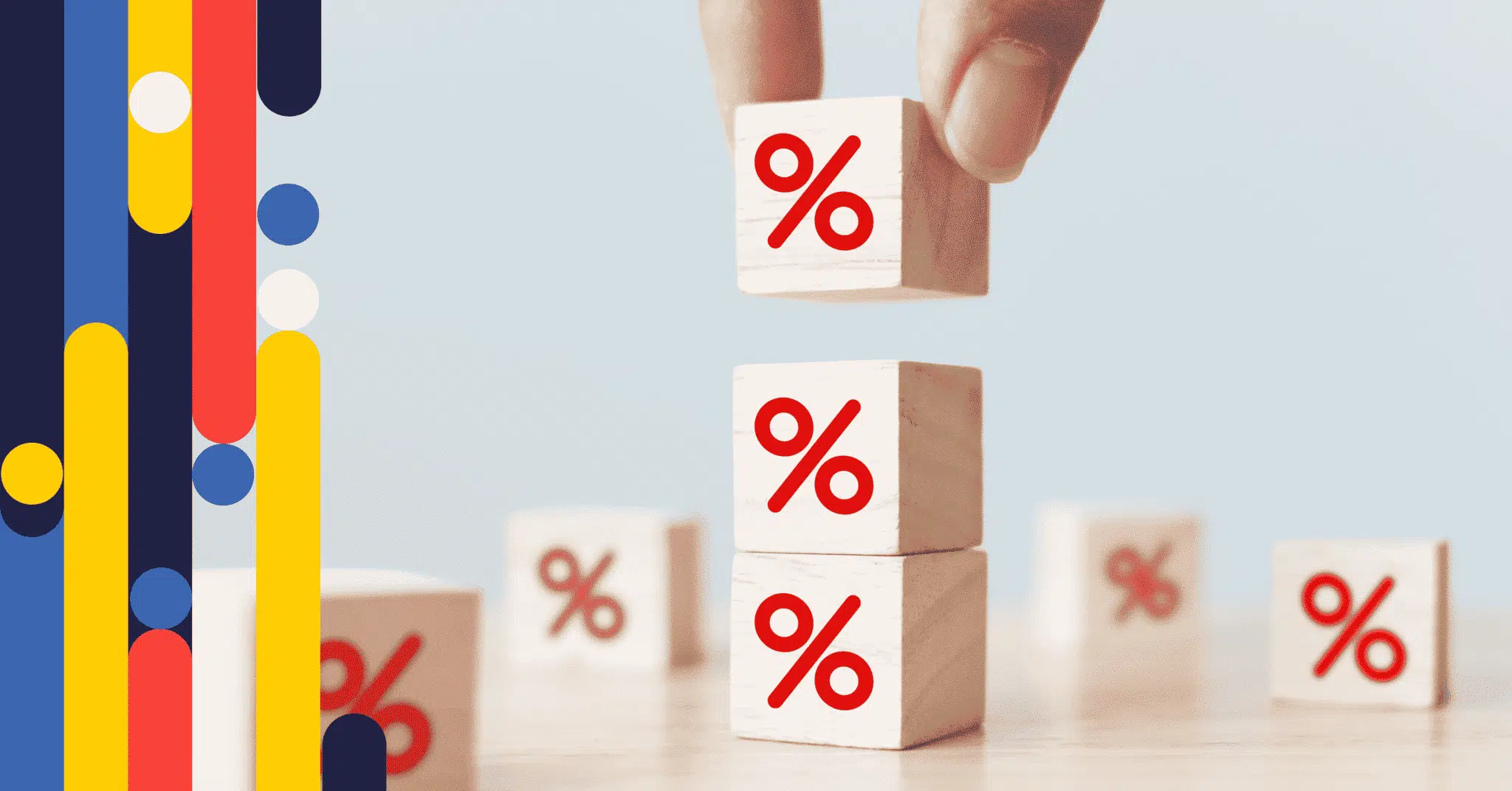Understanding APR vs Interest Rate in Canada

Table of contents
Understanding the difference between annual percentage rate (APR) and interest rate is crucial when comparing mortgages, car loans, or other financial products in Canada. Confusion between these terms often leads to unexpected costs and frustration. Clearly distinguishing between APR and interest rate helps Canadians make decisions with confidence and avoid unpleasant surprises by evaluating their actual cost of borrowing (COB) on equal terms.
Key Takeaways
- Interest rates only represent the cost of borrowing for the loan amount.
- APR includes the interest rate and its compounding factor, as well as any additional lender fees and closing costs, revealing the actual cost of borrowing.
- APRs provide a means of comparing any two financing options regardless of their interest rate.
What Is an Interest Rate?
An interest rate is the percentage lenders charge borrowers to loan money. It represents only the essential cost of borrowing the principal amount, without additional fees or charges. The interest rate is influenced by various factors, including market conditions, inflation, your credit score, and monetary policies set by the Bank of Canada. Interest rates come in two main types: fixed rates, which remain constant throughout the loan term, and variable rates, which fluctuate in response to market changes.
Factors Affecting Interest Rates
Several factors shape interest rates in Canada, and understanding these can help you anticipate future rate changes and manage your mortgage and debt strategy effectively.
- Economic conditions: Economic growth, unemployment, and inflation directly impact interest rates on new mortgages.
- Bank of Canada policies: Changes to the overnight rate directly influence the rates lenders charge on variable and adjustable mortgages.
- Government of Canada Bond Yields: Changes in bond yields affect the interest rates lenders charge on fixed mortgages.
- Personal finances: Your credit score, income stability, and existing debts determine your risk level and the interest rates you are offered.
- Competition: Competition among banks and lenders can drive rates down, benefiting consumers.
What Is APR?
The annual percentage rate (APR) provides a comprehensive view of borrowing costs, expressed as a percentage, that encompasses any additional fees and the total interest charged by the lender. Unlike interest rates alone, the APR on mortgages encompasses not only interest compounding but also fees such as administrative charges, legal and transfer fees, and appraisal costs.
However, for subprime mortgages, additional costs may affect the APR, including broker commissions and origination fees. This broader view helps borrowers make accurate comparisons and better understand what they’ll pay over the life of their loan or mortgage.
Typical Fees Included in APR
You’ll need to factor all of these fees into the APR to understand your total cost of borrowing (COB). Being aware of these fees ensures transparency and reduces potential financial surprises down the road.
- Origination fees: These are initial charges paid to the lender for processing your loan.
- Administrative and processing fees: These fees cover the lender’s administrative expenses.
- Appraisal fees: These fees are typically paid by the borrower for property valuations required by lenders.
Broker fees: Commissions paid to mortgage brokers or intermediaries for referring borrowers to lenders. Commission may also be split between the broker and the lender.
Mortgage payment plans aren’t meant to be one-size-fits-all.
Chat with a nesto mortgage expert & get a mortgage payment fit to you.
Key Differences Between APR and Interest Rate
While the interest rate is simply the cost of borrowing the principal amount, APR represents the total annualized borrowing cost, including both interest and fees. This results in APR typically being higher than the stated interest rate. Comparing APRs between lenders ensures you’re assessing loans on equal terms, allowing you to select the most affordable option.
APR vs Interest Rate Example
To illustrate the difference between APR and interest rate clearly, let’s consider a simple mortgage scenario:
If Lender A offers a mortgage with an interest rate of 3% but charges additional fees that equate to 0.5%, the APR would be approximately 3.5%. Conversely, Lender B offers the same interest rate of 3%, but with fewer fees of 0.2%, resulting in an APR of only 3.2%. In this scenario, lender B offers a more affordable borrowing option.
Calculating APR
APR calculation might seem complex, but in essence, it involves totalling the interest and additional fees, dividing this total by the loan amount, and adjusting for the term length. In Canada, lenders are required to disclose the APR, thereby simplifying the comparison process for borrowers and ensuring transparent lending practices.
Mortgage Compounding Affects Your Effective APR
The compounding frequency plays a critical role in how your mortgage’s annual percentage rate (APR) is calculated, and ultimately, how much you’ll pay over time. While the interest rate gives you a high-level idea of borrowing costs, it doesn’t reflect the mortgage compounding factor, which is how often interest is added to your balance. That’s where the effective rate comes in. APR incorporates this compounding effect, along with additional lender fees, to provide a more accurate picture of your total borrowing cost.
For example, a fixed-rate mortgage that compounds semi-annually will generate less total interest than a variable-rate mortgage with monthly compounding, even if both advertise the same interest rate. Since APR factors in how frequently interest is charged, the APR on a variable mortgage is typically higher than that of a fixed mortgage at the same posted rate. This is why it’s crucial to look beyond the interest rate and ask your lender for the effective annual percentage rate (APR).
Why Understanding APR Matters for Canadian Borrowers
Understanding APR empowers Canadian borrowers by revealing the actual cost of financial products, ensuring transparency and preventing unforeseen expenses. Whether you’re considering a mortgage renewal, a home purchase, a refinance, a new car loan, or a personal loan, being aware of the APR allows you to choose the best product, saving you money in the long term and avoiding costly financial mistakes.
Tips for Comparing Financial Products
When evaluating financial products, Canadians should consider the following tips to confidently select the products that best suit their needs and budgets.
- Always request the APR: This provides a clear comparison of actual borrowing costs.
- Consider APR alongside the interest rate: While both are important, APR gives the most comprehensive view.
- Understand the impact of loan duration: Shorter-term loans often have a higher APR due to upfront fees, whereas longer-term loans spread costs out, which can sometimes lower the APR.
We’re curious…
Frequently Asked Questions (FAQ) about APR vs Interest Rates
Is APR or interest rate more meaningful when comparing loans?
While both matter, the APR provides a more comprehensive picture, as it includes the interest rate and any additional fees that may be applied. It’s always best to use APR for accurate comparisons between mortgage loans.
Can I negotiate a better APR in Canada?
Negotiating interest rates is common, especially when you have good credit or are considering competing offers from other lenders. However, the additional fees making up the APR are often less negotiable. It’s always worthwhile to discuss with your lender and explore all possibilities, including any cash back incentives from the lender to cover your fees.
Does a low interest rate guarantee a low APR?
A low interest rate doesn’t necessarily guarantee a low APR; it may still come with high fees, which can increase the APR, negating any savings from the lower interest rate. Always check the APR to ensure you fully understand the borrowing costs associated with your loan.
What is a typical APR for mortgages in Canada?
The Mortgage APR typically ranges slightly higher than the quoted interest rate, generally by 0.2% to 0.5% more. For instance, a mortgage with a 4% interest rate typically has an APR of around 4.2% to 4.5%. However, the APR on a mortgage will depend on the type of mortgage transaction that you’re looking to do. For example, lenders may cover the cost of a standard mortgage transfer, whereas your lender may require you to pay for a collateral transfer.
What does 0% APR mean?
A 0% APR indicates no interest or fees during a specified promotional period. Regular rates will apply after this period ends, so thoroughly understand the terms to avoid unexpected charges.
Final Thoughts
Understanding the difference between APR and interest rate isn’t just helpful, it’s essential for making wise financial decisions in Canada’s complex lending environment. While interest rates offer a surface-level look at borrowing costs, APR reveals the complete picture, including the often-overlooked fees that impact the total amount you’ll pay over time. Whether you’re taking out a mortgage, renewing an existing one, or considering other loan products, focusing on APR helps you avoid surprises and compare offers more accurately.
At nesto, we know that transparency leads to better decisions. If you’re unsure how to weigh your options or want expert guidance tailored to your financial goals, speak with a nesto mortgage expert today. We’ll help you break down both APR and interest rates to find the most affordable mortgage for your needs, with no hidden fees and no guesswork.
Why Choose nesto
At nesto, our commission-free mortgage experts, certified in multiple provinces, provide exceptional advice and service that exceeds industry standards. Our mortgage experts are non-commissioned, salaried employees who provide impartial guidance on mortgage options tailored to your needs and are evaluated based on client satisfaction and advice quality. nesto aims to transform the mortgage industry by providing honest advice and competitive rates using a 100% fully digital, transparent, seamless process.
nesto is on a mission to offer a positive, empowering and transparent property financing experience – simplified from start to finish.
Contact our licensed and knowledgeable mortgage experts to find your best mortgage rate in Canada.
Ready to get started?
In just a few clicks, you can see our current rates. Then apply for your mortgage online in minutes!















